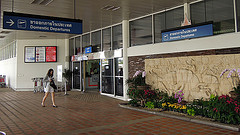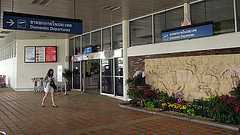Thailand’s GDP is expected to raise by up to 3.5 percent in 2015, according to the World Bank’s Thailand Economic Monitor 2015.
The country’s economy grew only by 0.9 percent in 2014 and the lull was largely due to political issues as well as lower export demands from China and other dominant Southeast Asian countries, according to the report. But 2015 is expected to promise more for the country with the report attributing factors including lower oil prices, increased tourism receipts, and higher public spending as the reasons for the buoyancy.
Thai exports are expected to continue their slow growth and the report throws light on the slow growth of export in the country since 2012. It is revealed that the export growth slowed to less than 1 per cent in the period of 2012-2014 due to the country losing its competitive edge in the region. Thailand’s market share in world exports has also declined correspondingly in this same period.
“Thailand has seen high growth in the past. Further improvements in competitiveness will be important for sustained economic growth and rising incomes for the Thai people,” said Ulrich Zachau, World Bank Country Director for Southeast Asia.
The World Bank report also points out that upskilling the labor force is critical to improving Thailand’s competitiveness. The report also thrusts on education reform in the coastal nation.
Meanwhile, a Reuters report last month indicated that an economic growth rate of three percent for Thailand in 2015 will be a challenge according to the country's central bank governor. While GDP in the first quarter was expected to contract on a quarterly basis, year-on-year growth would be around 3 percent, he said, pitching the forecast at a level well below the Thai government’s official estimate.
The country’s economy grew only by 0.9 percent in 2014 and the lull was largely due to political issues as well as lower export demands from China and other dominant Southeast Asian countries, according to the report. But 2015 is expected to promise more for the country with the report attributing factors including lower oil prices, increased tourism receipts, and higher public spending as the reasons for the buoyancy.
Thai exports are expected to continue their slow growth and the report throws light on the slow growth of export in the country since 2012. It is revealed that the export growth slowed to less than 1 per cent in the period of 2012-2014 due to the country losing its competitive edge in the region. Thailand’s market share in world exports has also declined correspondingly in this same period.
“Thailand has seen high growth in the past. Further improvements in competitiveness will be important for sustained economic growth and rising incomes for the Thai people,” said Ulrich Zachau, World Bank Country Director for Southeast Asia.
The World Bank report also points out that upskilling the labor force is critical to improving Thailand’s competitiveness. The report also thrusts on education reform in the coastal nation.
Meanwhile, a Reuters report last month indicated that an economic growth rate of three percent for Thailand in 2015 will be a challenge according to the country's central bank governor. While GDP in the first quarter was expected to contract on a quarterly basis, year-on-year growth would be around 3 percent, he said, pitching the forecast at a level well below the Thai government’s official estimate.



















